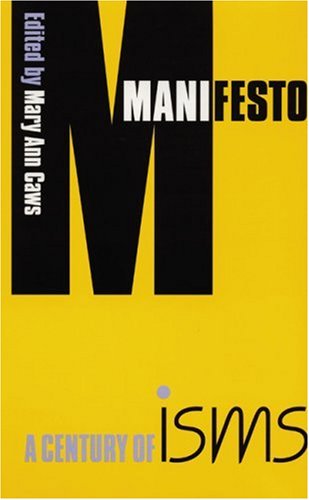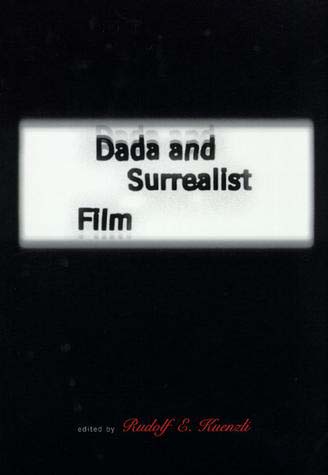Mary Ann Caws (ed.): Manifesto: A Century of Isms (2001)
Filed under book | Tags: · art, art criticism, art history, avant-garde, bauhaus, cubism, dada, de stijl, expressionism, fauvism, futurism, history of literature, imagism, lettrism, literature, manifesto, modernism, surrealism, symbolism, vorticism

“An anthology featuring over 200 artistic and cultural manifestos from a wide range of countries. It includes texts ranging from Kurt Schwitters’ ‘Cow Manifesto’ to those written in the name of well-known movements – imagism, cubism, surrealism, symbolism, and projectivism – and less well-known ones – lettrism, acmeism, concretism, and rayonism.”
Publisher University of Nebraska Press, Lincoln, 2001
ISBN 0803264070, 9780803264076
xxxiv+713 pages
Reviews: Greil Marcus (Artforum, 2001), Publishers Weekly (2001), Gail McDonald (symploke, 2003), Cynthia Ellen Patton (College Literature, 2003).
PDF (14 MB, updated on 2017-11-21)
Comment (0)Rudolf E. Kuenzli (ed.): Dada and Surrealist Film (1987)
Filed under book | Tags: · art history, cinema, dada, film, film history, surrealism

“This collection of thirteen original essays analyzes connections between film and two highly influential twentieth-century movements. The essays, which comment on specific films and deal with theoretical and topical questions, are framed by a documentary section that includes a photographic reproduction of the manuscript scenario for Robert Desnos’s and Man Ray’s L’Etoile de mer, and an introduction by the editor that provides a cogent working model for the difference between Dada and Surrealist perspectives.” (back cover)
Publisher Willis Locker & Owens, New York, 1987
This edition by MIT Press, 1996
ISBN 026261121X, 9780262611213
254 pages
Reviews: Andrew Horton (Film Quarterly, 1990), Bettina L. Knapp (L’Esprit Créateur, 1990).
PDF (75 MB, no OCR)
Comment (0)Albert Glinsky: Theremin: Ether Music and Espionage (2000)
Filed under book | Tags: · biography, electronic music, music, music history, politics

“Leon Theremin led a life of flamboyant musical invention laced with daring electronic stealth. A creative genius and prolific inventor, Theremin launched the field of electronic music virtually singlehandedly in 1920 with the musical instrument that bears his name. The theremin-–the only instrument that is played without being touched-–created a sensation worldwide and paved the way for the modern synthesizer. Its otherworldly sound became familiar in sci-fi films and even in rock music. This magical instrument that charmed millions, however, is only the beginning of the story.
As a Soviet scientist, Theremin surrendered his life and work to the service of State espionage. On assignment in Depression-era America, he became the toast of New York society and worked the engines of capitalist commerce while passing data on U.S. industrial technology to the Soviet apparat. Following his sudden disappearance from New York in 1938, Theremin was exiled to a Siberian labor camp and subsequently vanished into the top-secret Soviet intelligence machine, presumed dead for nearly thirty years. Using the same technology that lay behind the theremin, he designed bugging devices that eavesdropped on U.S. diplomatic offices and stood at the center of a pivotal cold war confrontation. Throughout his life, Theremin developed many other electronic wonders, including one of the earliest televisions and multimedia devices that anticipated performance art and virtual reality by decades.
In this first full biography of Leon Theremin, Albert Glinsky depicts the inventor’s nearly one hundred-year life span as a microcosm of the twentieth century. Theremin is seen at the epicenter of most of the major events of the century: the Russian Revolution, two world wars, America’s Great Depression, Stalin’s purges, the cold war, and perestroika. His life emerges as no less than a metaphor for the divergence of communism and capitalism.”
Foreword by Robert Moog
Publisher University of Illinois Press, 2000
ISBN 0252025822, 9780252025822
xvi+403+[30] pages
Reviews: Irina L.Vanechkina (Leonardo, 2001), Hans-Joachim Braun (Tech Cult, 2001), Mark Polishook (Notes, 2001), Ann Warde (Comp Music J, 2002), Kyle Gann (Am Music, 2003).
PDF (138 MB, no OCR)
Comment (0)
